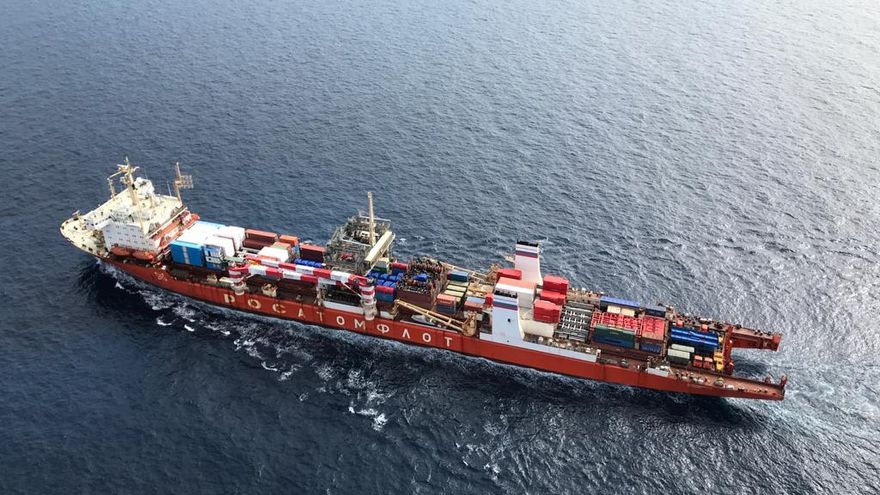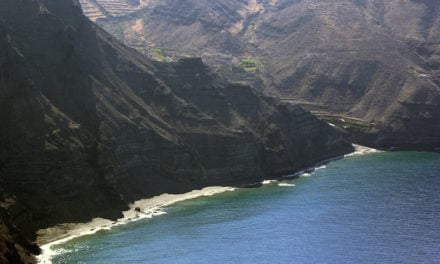The Sevmorput, a Russian nuclear-powered cargo ship, the only one of its kind in service, that has been slowly transiting through the Canary Islands waters is now more than 200 nautical miles northeast of Lanzarote, and moving away from the archipelago after its captain had to be evacuated on Wednesday night, suspected to be suffering from meningitis. The ship, heading to its home port of Saint Petersburg, will be repaired after a mechanical problem forced it to abandon its onward journey, headed for Antarctica.
The Nuclear Safety Council reports that the Russian ship “has not notified the International Atomic Energy Agency of any type of nuclear incident, a notification that would be mandatory if any type of anomaly had been detected in the ship, that could pose a risk of release of radioactive material”, said a statement from the Merchant Marine Directorate General.

Nuclear-powered cargo ship Sevmorput passing Canary Islands on Tuesday December 15 – Image: Salvamento Maritimo
The 32 year-old nuclear-powered cargo ship was forced to turn around following a failure in one of its propeller blades, back in October, off the coast of Angola, where it zig-zagged for more than three weeks in coastal waters, raising concerns about the ship’s condition. Having been unable to repair the damage at sea, and due to very few ports being willing to allow the unusual vessel to stop, it has been slowly heading north past the Canary Islands on its way back home. The evacuation of the ship’s Captain, Oleg Markov, to a Gran Canaria Hospital occurred last night with the assistance of a Maritime Rescue helicopter, after 21:00, returning 45 minutes later to its base on Gran Canaria. A second aircraft had also been deployed from Tenerife, but then returned to base. Once the rescue was finished, the freighter resumed its journey toward Russia, to be repaired in the port of Saint Petersburg, with the first officer now in command of the crew.
The Sevmorput had changed course in the morning to take the route farthest possible from the Canaries. The strange zigzag movement was repeated on Tuesday by the container ship, when it was 70 nautical miles south of the Canary Islands, and with its nuclear reactor fuelled by up to 150 kilos of enriched uranium, further concerns were expressed as to the seriousness of any threat that might be posed by the ship, prohibited from entering most ports and jurisdictional waters around the world.
Diplomatic negotiations between Spain and Morocco and Russia, whose government is responsible for the ship, under close surveillance by the Spanish Merchant Navy and Moroccan maritime authorities, as well as the standing prohibition of its entry to the jurisdictional waters of both countries, led the Sevmorput crew to abandon their proposed route via the international corridor between Tenerife and Gran Canaria, instead turning east at first light to head to the midway point between Fuerteventura and the African coast. This 25-mile corridor of international waters is furthest away from the two island capitals, the cities with the largest populations in the region.
The loss of one of the vessels four propeller blades, was described as “incomprehensible” by Russian media in mid-October, forcing the nuclear freighter to abandon the rest of its planned journey. The course it followed yesterday and today put the ship parallel to the limits of the Canary Islands and Moroccan jurisdictional waters. After Markov was evacuated, the vessel continued on at a rate of just 10 knots, a much slower pace than usual due to the technical problems, with its load of more than 25,000 tons. The ship is transporting prefabricated modules from Vostok that were meant for the expansion of the Russian Antarctic polar base.
Spain’s Merchant Marine General Directorate, on Tuesday, contacted the Nuclear Safety Council and sent one of their Maritime Rescue helicopters to carry out a reconnaissance flight that morning. The aircraft flew over the container ship at 10:30, when it was passing Cape Bojador, northwest of Western Sahara, and about 60 miles from Gran Canaria, to take images of the vessel on a surveillance mission. The captain of the Sevmorput, before being rescued last night due to his health problems, had communicated to the Merchant Marine that “the machinery and mechanical equipment on board the ship are working correctly and at the present time, and throughout the entire voyage has produced no incidents or failure of nuclear equipment on board the ship”.
 The Sevmorput nuclear-powered cargo ship was built in 1988 in the Crimean peninsula, using now long outdated and highly polluting nuclear technology, and was destined to be scrapped after 9-years out of service, between 2007 and 2016, after Atomflot, the agency that operates Russia’s fleet of civilian nuclear-powered vessels, recovered the vessel to expand a scientific base at the South Pole. One of the reasons for concern is that this ship releases nuclear fission waste as part of its normal operating parameters.
The Sevmorput nuclear-powered cargo ship was built in 1988 in the Crimean peninsula, using now long outdated and highly polluting nuclear technology, and was destined to be scrapped after 9-years out of service, between 2007 and 2016, after Atomflot, the agency that operates Russia’s fleet of civilian nuclear-powered vessels, recovered the vessel to expand a scientific base at the South Pole. One of the reasons for concern is that this ship releases nuclear fission waste as part of its normal operating parameters.
The captain also confirmed to the Spanish Merchant Navy that 98 crew members are on board, and that it was forced to carry out repairs in mid-October after losing one of the four blades from its only propeller. Russia’s state owned Nuclear Energy Corporation, Rosatom, told French press agency AFP that it needed “repairs to the propeller and rudder system,” as it plowed through the West African tropical waters, off Angola. With capacity for more than 1,400 containers it can carry a maximum cargo of 35,000 tons. Initial attempts by specialized divers to repair the propeller by removing another blade to restore symmetry failed. The work was apparently complicated by bad weather and the complexity of working with this unique ship, powered with a nuclear reactor. The decision on December 2 to return home, followed failed negotiations with the authorities of Angola and of South Africa, to carry out the repairs in either Luanda or Cape Town, but they were refused entry to those ports.
 The vessel was scheduled to be scrapped before undergoing its significant refit, on a floating dock north of Murmansk. This floating dock itself sank in 2018, so the Sevmorput was directed to a shipyard in St Petersburg in 2019 for maintenance work, hull repair and replacement of the propeller shaft, with its latest maintenance revision back in January, less than a year ago. It has all of its operating permits in order, which is why there is such surprise back in Russia, with Russian media reporting that Atomflot is going to open an investigation to determine the causes of the problem. The propeller is supposedly designed to work in the very harshest conditions, breaking through large ice sheets, but lost one of its four blades in calm tropical waters and in open sea, just 500 miles from the African coast, where the average depth is around 2,000 meters.
The vessel was scheduled to be scrapped before undergoing its significant refit, on a floating dock north of Murmansk. This floating dock itself sank in 2018, so the Sevmorput was directed to a shipyard in St Petersburg in 2019 for maintenance work, hull repair and replacement of the propeller shaft, with its latest maintenance revision back in January, less than a year ago. It has all of its operating permits in order, which is why there is such surprise back in Russia, with Russian media reporting that Atomflot is going to open an investigation to determine the causes of the problem. The propeller is supposedly designed to work in the very harshest conditions, breaking through large ice sheets, but lost one of its four blades in calm tropical waters and in open sea, just 500 miles from the African coast, where the average depth is around 2,000 meters.
With luck, it is just the Sevmorput’s captain that it leaves behind and his recovery will be speedy. Environment activists have voiced concern that the vessel will be passing several European countries during the winter storm season. It is scheduled to arrive at St. Petersburg on December 31.










